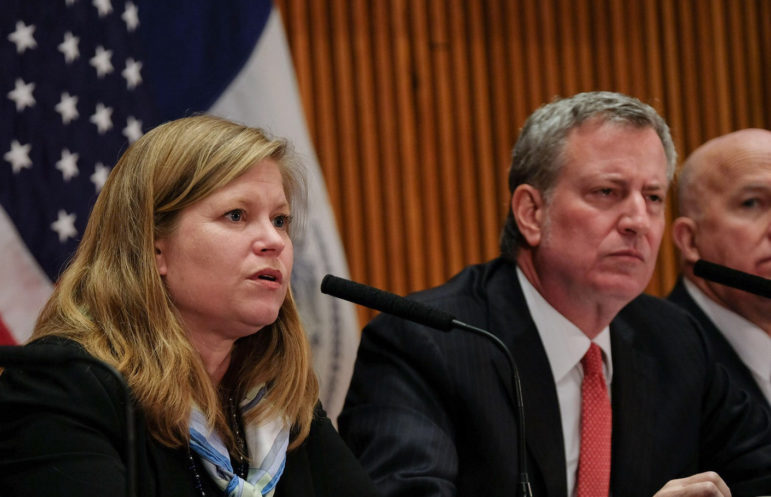
Ed Reed/Mayoral Photography Office
Kathryn Garcia, seen here as Sanitation Commissioner at a 2018 event with the mayor, is now leading NYCHA on an interim basis.
When Kathryn Garcia arrived at NYCHA in February to take over the beleaguered housing authority on an interim basis, she says, she expected to confront a situation that was “pretty dire because of what I read in the news before I took this role.”
She wasn’t far off. The effects of 20 years of disinvestment were apparent. But, says, Garcia, “What I did see when I got here were the beginning pieces of progress in order to create a longterm successful plan for NYCHA to stabilize the Authority and move forward.”
That’s a work in progress, she told WBAI’s Max & Murphy on Wednesday. While the authority has “stabilized thousands of apartments that had presumed or lead-based paint with children under 6,” she says, “We still have a lot more to do.” X-ray testing of 134,000 apartments for lead paint began in April and, she says, “It will take us till end of 2020 to get that done.”
Fixing the issues that have generated headlines, lawsuits and a federal criminal probe — like lead paint, mold, rodents, heat and hot water — is only part of the job facing NYCHA. “There’s also a longer term goal: How do we drive investment into these buildings? Because they are assets of city and critical homes for all of the residents, and [we’re] thinking about how that can occur, whether it’s using the Obama-era RAD program, or what we call the Build to Preserve program to ensure residents are seeing impact as quickly as possible.”
RAD, or Rental Assistance Demonstration, is one of the programs NYCHA plans to use to convert some 62,000 of its 176,000 units from public housing to Section 8. Build to Preserve is the initiative to construct 100 percent affordable and 50/50 affordable/market-rate buildings on NYCHA land and use lease payments to address maintenance issues. Both are controversial because they involve private-sector interests. “We have taken real care to make sure NYCHA is still owner of land and a development partner in the deal we have control going forward and that we can be protective of our residents no matter what,” Garcia insists.
One signal feature of the NYCHA controversy is that for all the pressure from Gov. Cuomo and all the scolding by the Department of Housing and Urban Development, neither entity has come through with what NYCHA needs even more than constructive criticism: money. Both Albany and Washington have historic funding responsibilities for NYCHA on par with, if not greater than, the city’s. The state allotted $450 million years ago but Garcia is still waiting for that money and not a dime was earmarked for NYCHA in the current state budget. And the feds forced the city to pony up billions without promising to correct years of underfunding of both operations and capital work.
Get the best of City Limits news in your inbox.
Select any of our free weekly newsletters and stay informed on the latest policy-focused, independent news.
But Garcia remains optimistic that will change. “I see a lot of advocates and residents and people in federal and state government coming together to say, ‘What can we do to help?’ While the federal government hasn’t put in money yet, I remain hopeful. The state has put in funding to do elevator work and additional boiler work.”
Listen to the interview below. Or hear the full show, which includes a talk with Sarah Watson of the Citizens Housing and Planning Council about what, if any, lessons New York can learn from London’s 1990s push to regenerate public housing.
Max & Murphy: Interim CEO and chair of NYCHA, Kathryn Garcia
Full Show of May 29, 2019: The Present and Future of Public Housing in NYC








